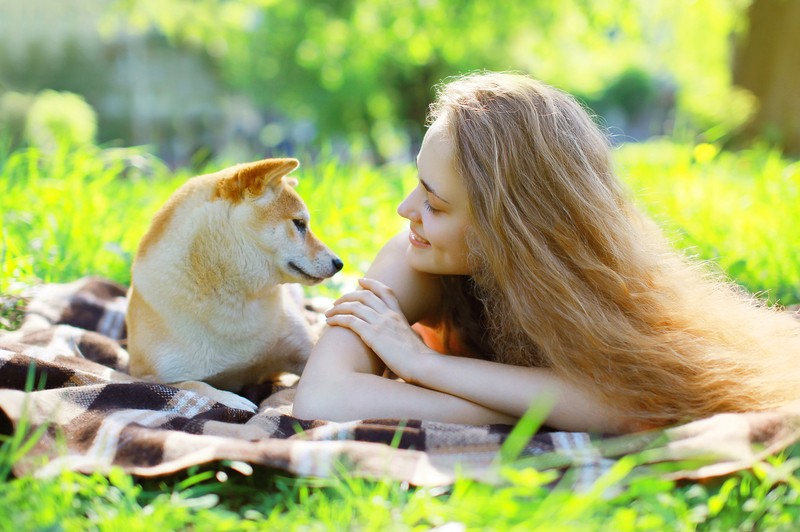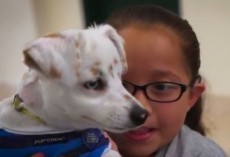These easy tips and tricks will get you and your pooch better connected. It'll almost be like you're developing psychic powers that'll help you speak with your furry pal in a deeper way.
You'll even amaze your friends and maybe get them to learn a thing or two!
Most dog and cat lovers already understand canine and feline body language, which is one non-verbal technique. But you can use your other, natural, nonverbal communication skills, and actually begin to see things through your dog or cat’s eyes, and become his/her voice.
Those of us fortunate enough to have been raised with animal companions probably “talked” to them all the time—and they “talked” back—without words. You didn’t have to be Dr. Doolittle to do it, either.
You can try it anytime with your own dog or cat, simply by listening to your heart, instead of to your head with its endless, meaningless chatter.
It is very important to always communicate in positive terms— “see” what you want your dog or cat to do, rather than focusing on unwanted behaviors. Dogs and cats live fully in the moment, so picture them as you want them to be. Unlike us, dogs and cats live in the moment. What lessons we can learn about being here—right now!
Practice visualizing positive, loving pictures rather than negative, worrying ones.
This is so crucial when communicating with your animal companions. If you say, for example (either out loud or nonverbally), “Don’t jump on the couch,” your dog or cat sees an image in your mind’s eye of him jumping on the couch. Instead, say and visualize what you DO want him to do. In this case, you would say, in an even but stern tone, “Go to your bed!” Then gently carry or lead him to his bed to reinforce the positive behavior.
It’s impossible to hide your feelings from dogs and cats. They always know—and they may “get it” even before we know ourselves. Their sensibilities should be respected.
You can also practice this pure heart-to-heart communication skill with a new pet, or with animals at dog or cat shows or shelters, or even at your vets office.
To start, if you can, get down a bit lower than normal (ideally, at the animal’s eye level) and imagine the dog or cat sitting on the floor of your own home. You may get a response as a picture of what his own home looks like from his point of view.
If you don’t get a picture, it doesn’t mean you’re not doing it right. The dog may just be telling you he’s not allowed in that room. Keep going anyway, and just let him talk through his own senses.
What are you getting? Now visualize the cat or dog’s feeding area. What kind of food does he eat? Do you taste or feel any textures in your mouth? He may change the picture you send to reflect his truth, and he may present it to all of your senses or just some of them.
Cats may have little balls and catnip toys, and dogs may have chew toys, tennis balls, or maybe even a Frisbee. Give him these images and see what you get back. After you present an image to him, remember to leave a space for him to answer.
You may receive feelings of space and expansion if he has room to play and places to rest in—or feelings of contraction if he’s been caged or otherwise too restricted.
You can use your nonverbal skills to assess the animal’s well-being through a mental body scan. Just look at the animal, starting with the head and working down the back to the tip of the tail. How do you feel compared with how you felt before scanning? If you feel anything unusual as you continue your scan, you may be on to something.
If you don’t have permission to touch the animal, you can pet the cat or dog’s aura. Then when you use this indirect way of laying on hands by petting the space around the body (which is referred to as the etheric double), you can often feel the animal’s energy and determine whether he is receptive to your touch, which after all will leave your scent on this dog or cat.
When doing a mental body scan, you may feel discomfort in certain parts of your own body. While this is important information, you do not need to hold it in your body. Simply release the feeling and say to yourself,“This animal’s feelings are his own. I release them.”
Nonverbal communication seems to come most easily with other people’s animals. It’s sometimes difficult to practice with our own furry friends because we are so emotionally involved with them.
Be sure to talk to your animal companions about their day. Just give them the time and the space to get it all off their chests.
Nonverbal communication can greatly expand your relationship with animals, but some dogs and cats are reserved, just like certain people are. Don’t be discouraged. Trust yourself, and proceed with openness, imagination and confidence.
That was such an interesting lesson in nonverbal communication. It's always a great thing to have a strong bond with your furry friend but this really takes it to another level! Don't be afraid to try this with your pooch at home. Remember to be patient, you might not get it right the first time.
For more information on nonverbal communication with animals, be sure to visit Care2.










